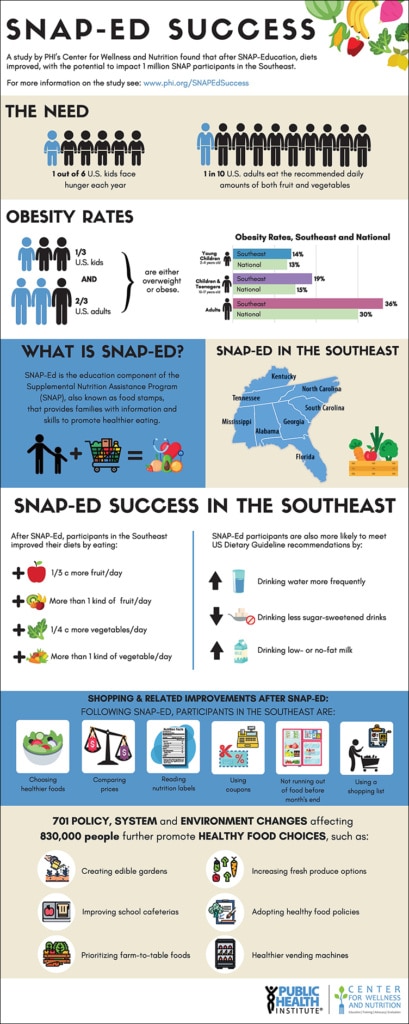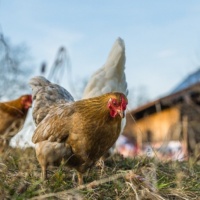A little education goes a long way when it comes to helping people with limited budgets eat healthier and not run out of food before the end of the month.
So says a study by the Public Health Institute ‘s Center for Wellness and Nutrition, published in the Journal of Nutritional Science.
It found that residents with low incomes in eight Southeastern states, including Kentucky, “consumed significantly greater amounts of fruits and vegetables, and improved several other shopping and nutrition-related behaviors” after they participated in the U.S. Department of Agriculture ‘s SNAP-Ed program. SNAP is the Supplemental Nutrition Assistance Program, formerly known as food stamps.
“Healthy foods can be expensive, and a SNAP budget is modest. But SNAP-Ed is helping low-income Americans in the Southeast make strategic choices that stretch their food dollars and empower them to choose more fruits and vegetables and other healthy foods,” Amy DeLisio, the center’s director and co-author of the study, said in a news release .
“In the long run,” DeLisio said, “these changes can play an important role in reducing their likelihood of diabetes, hypertension and other nutrition-related diseases, and in reducing health-care costs across the region.”
SNAP-Ed provides comprehensive nutrition education and obesity-prevention interventions for individuals and families whose incomes are below 185% of the federal poverty line. Participants are not required to get SNAP benefits.
Using 2017 data from 25 participating agencies in the Southeast, including surveys from more than 43,000 low-income children and adults before and after SNAP-Ed interventions, the study found people were more likely to meet USDA nutrition recommendations and manage their food resources better after participating in the program.
On average, the study found low-income participants increased their daily consumption of fruit by 1/3 cup; increased their daily consumption of vegetables by 1/4 cup; drank more water and less sugar-sweetened drinks, and were more likely to drink low-fat or nonfat milk.
They were also likelier to choose healthier foods on a budget; read nutrition labels or ingredient lists; compare prices before purchasing foods; identify foods on sale or use coupons; use a list while shopping; and not run out of food before the month’s end.
The report notes that in a region that experiences some of the highest rates of obesity and unhealthy dietary behaviors in the nation, “our study shows that SNAP-Ed programs can be part of the solution.”
The study also documented 701 policy, systems and environment supports that complement the SNAP-Ed programs in the region, including things like creating edible gardens and improving food displays in school cafeterias.
What about Kentucky?
In Kentucky, the Nutrition Education Program encompasses two separate USDA programs, SNAP-Ed and the Expanded Food and Nutrition Education Program. The programs are offered in each of the state’s 120 counties and are run by extension agents or one of the 96 NEP assistants.
NEP director Marisa Aull said the program is designed to provide its clients with life skills to promote a healthier lifestyle and to make the healthiest choice the easiest choice.
“A lot of times it is simply lack of knowledge,” Aull said. “Our program really does focus on bringing education to the individual so that they, along with their family, can make those choices and be healthier.”
Omolola Adedokun, senior Extension specialist for evaluation, explained, “With education on how to spend the money, by using coupons, by being able to follow what’s on sale, what’s not on sale, and by budgeting for food, that by looking at cheaper options, like frozen vegetables, or canned vegetables, people will be able to eat healthier and in alignment with USDA guidelines.”
Aull said the program is especially important in Kentucky, a state known for its high obesity rates and poor health.
According to America’s Health Rankings , Kentucky is one of the worst states for adult obesity, with 36.6% of its adults obese. Its child obesity rate of 38% is second highest in the nation, according to the 2020 Kids Count report.
Kentucky also ranks among the 10 worst for heart disease and diabetes, and is No. 1 in cancer deaths — all conditions that could improve with better nutrition and exercise practices.
The study did not provide any state-specific data, but the 2019 NEP report says 97% of Kentucky’s adult participants showed improvement in one or more diet quality indicator, like eating more fruits or vegetables, drinking less sugared soda and cooking dinner at home; 84% increased their physical activity; 92% showed safer food storage and prep; and 91% showed better food resource management.
Kentucky had more than 4,500 participants in the SNAP-Ed program, said Adedokun.
As for youth, after participating in the “Super Star Chef” program, which was offered in 53 counties, 99.6% of the state’s 789 youth participants reported they could identify healthy foods; 96% said they planned to drink more water every day; and 95% said they planned to try new foods. The report says the two programs had 368,584 children and youth contacts.
Aull said young people are an important part of the program because they often share their excitement for what they’ve learned with their families, inspiring them to eat healthier.
“We often hear anecdotally, that they convince their family to try a new food or they convince their family to go to the farmers market where the family previously was maybe hesitant to go. . . . The key to the family is often through youth,” she said.
Aull stressed that each of these small changes are important because they could have a lifelong impact, and not just for the individual but society at large.
“If we look at it from a kind of return-on-investment side, it has an effect on generational poverty, it has an effect on their health and well-being, and it also has an effect on those local health care systems,” Aull said. “Those small changes lead to big impacts for not just our state as a whole but . . . their community, their city, their family. And we feel like those changes will also break a lot of cycles that need to be broken, that really are just due to lack of resources and lack of opportunity.”
Aull encouraged qualifying Kentuckians to participate in the free nutrition-education programs, which are being held virtually during the coronavirus pandemic.
Denise Rennekamp, assistant NEP director, spoke to the importance of community partnerships to promote the program. For example, she said Feeding Kentucky and other food banks help connect food-insecure Kentuckians with their program.
The number of Kentuckians on SNAP varies from month to month, with participation increasing since the pandemic came to Kentucky in March. In August, 606,216 Kentuckians received SNAP benefits.
Click on the Plan, Eat, Move website to learn more about the program.
Melissa Patrick is a reporter for Kentucky Health News, an independent news service of the Institute for Rural Journalism and Community Issues, based in the School of Journalism and Media at the University of Kentucky, with support from the Foundation for a Healthy Kentucky. She has received several competitive fellowships, including the 2016-17 Nursing and Health Care Workforce Media Fellow of the Center for Health, Media & Policy, which allowed her to focus on and write about nursing workforce issues in Kentucky; and the year-long Association of Health Care Journalists 2017-18 Regional Health Journalism Program fellowship. She is a former registered nurse and holds degrees in journalism and community leadership and development from UK.







